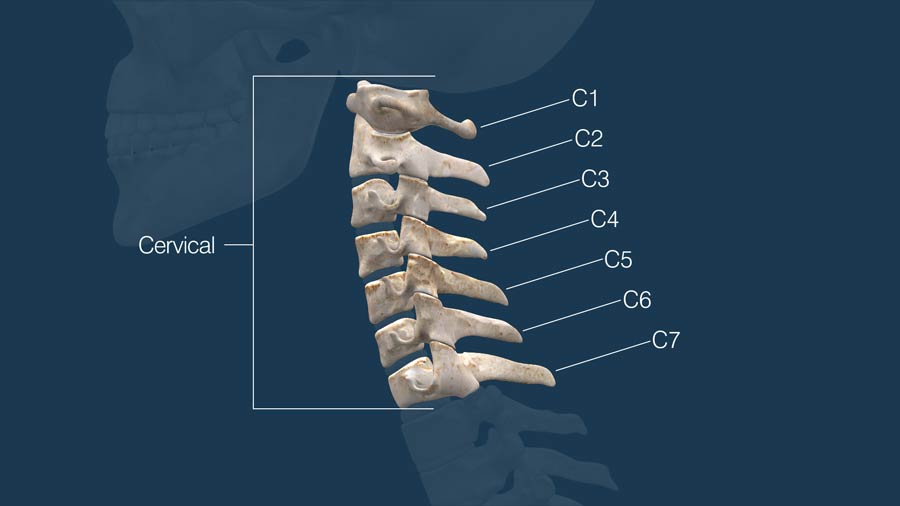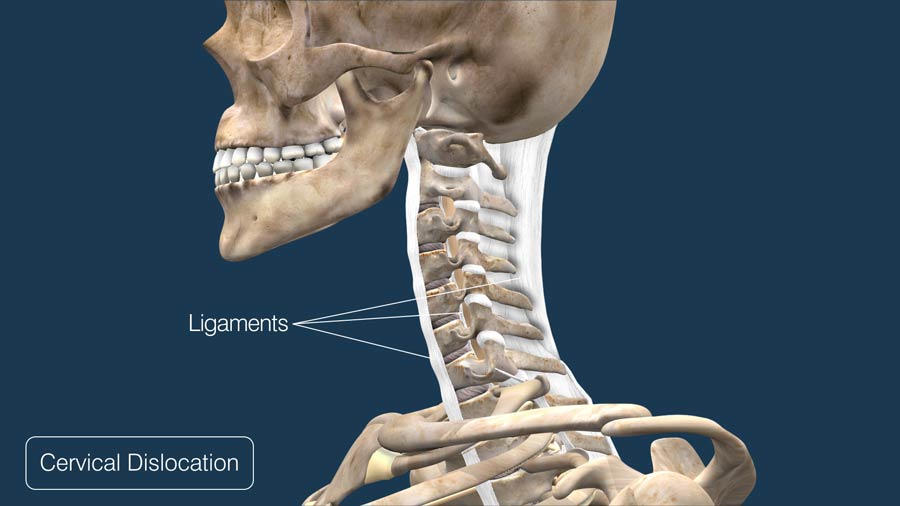Sports-Related Cervical Injuries in Children
The neck is the most mobile region of the spine and vulnerable to injury. In this video/blog, we’ll be taking a look at the most common sports-related cervical injuries in children and adolescents.

As resilient as children are, it’s not surprising that their growing bodies are at risk for injuries. A January 2021 study of trends in sports-related spine trauma shows that adolescents aged 14 to 17 had the highest rate of sports related neck injuries per year, compared to younger children between the ages of 4 and 13.
Types of injuries
A cervical spine injury refers to an injury in the neck. In this diagram, you can see the bones in the neck labeled C1-C7. The C refers to the cervical region and the number refers to each individual vertebrae or neck bone for a total of seven neck bones. You can also see the spinal cord embedded and protected within the bone and the nerves protruding to the side between each vertebrae.

Damage to the spinal cord in the cervical region may have severe consequences due to the proximity to the brain and downstream effects on the rest of the spine. Generally, the higher the level of injury on the spine, the more severe the effects of damage.
A broken neck bone is a more obvious finding on x-rays and CT scans. When an athlete complains, and has associated numbness, or nerve issues, these tests are standard ways to access for fractures. The treatment options will be determined by the type of fracture and the neurologic status of the injured athlete.
A type of common sports-related cervical injury is cervical dislocation. A cervical dislocation occurs when ligaments in the neck have been injured. It can also be associated with a fracture. Normally, the seven bones that make up your neck are connected to each other by a strong network of ligaments and muscles. A sprain or tear in the ligament can occur when a sudden movement causes the neck to bend at an extreme angle. Without a tight network of healthy ligaments to keep them aligned, two or more cervical bones become misaligned and separate or dislocate from each other. This abnormal movement of the bones causes instability and potential damage to the spinal cord and nerves.
A spinal cord injury without radiographic abnormality means that the patient shows symptoms of a spinal cord injury but the diagnostic tests fail to show evidence of a spinal fracture or instability. Although historically X-rays and CT scans didn’t show any spinal cord damage, current MRIs are now able to identify the relevant injury in ⅔ of cases. In addition, patients are known to show a wide range of neurological deficits such as numbness, tingling sensations, or paralysis. In most cases, spinal cord injury without radiographic abnormality occurs as a result of hyperextension forces, which cause the head to tilt back at an extreme angle, or from a direct impact to the face.

This 2021 study showed teenagers had the highest rates of upper and lower cervical fracture, dislocation, and spinal cord injury without radiographic abnormality. Unfortunately, adolescence and spinal cord injury without radiographic abnormality were both significant predictors of traumatic brain injury across sports.
14 to 17 year olds athletes are trending towards more muscle and more weight. The physical forces experienced will multiply with the mass of the body. As sports play becomes more competitive, young athletes are at greater and greater risk of injuring themselves and each other. This realization and growing concerns has prompted Organized Sports to be more deliberate when deciding it’s rules and regulations. I encourage everyone to participate in sports. I love watching the results of great competitions. It can be transformative in many positive ways. As a physician, I am also concerned for the health, safety and future of our young competitors. Play hard, but play safe. Until next time, this is Dr. Shim.
Additional Resources:
Citations
- Alas H, Pierce KE, Brown A, Bortz C, Naessig S, Ahmad W, Moses MJ, O'Connell B, Maglaras C, Diebo BG, Paulino CB, Buckland AJ, Passias PG. Sports-related Cervical Spine Fracture and Spinal Cord Injury: A Review of Nationwide Pediatric Trends. Spine (Phila Pa 1976). 2021 Jan 1;46(1):22-28. PubMed PMID: 32991512
- Szwedowski D, Walecki J. Spinal Cord Injury without Radiographic Abnormality (SCIWORA) - Clinical and Radiological Aspects. Pol J Radiol. 2014;79:461-4. PubMed PMID: 25505497
Last modified: June 23, 2021









